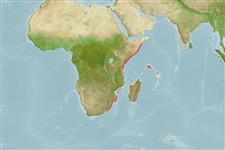>
Pleuronectiformes (Flatfishes) >
Bothidae (Lefteye flounders)
Eponymy: Dr James Leonard Brierley Smith (1897–1968) was a South African chemist and ichthyologist most famous for identifying a stuffed fish as a coelacanth, then thought to have been extinct for millions of years. [...] (Ref. 128868), visit book page.
More on author: Nielsen.
Environment: milieu / climate zone / depth range / distribution range
Ökologie
seewasser demersal; tiefenbereich 124 - 230 m (Ref. 10877). Tropical
Western Indian Ocean: known only from 3 specimens from off Durban, South Africa and Kenya. Generic placement questionable, but possibly closely related to Tosarhombus octoculatus from Japan.
Size / Gewicht / Alter
Maturity: Lm ? range ? - ? cm
Max length : 18.0 cm TL Männchen/unbestimmt; (Ref. 4417)
Rückenflossenstacheln (insgesamt) : 0; Rückenflossenweichstrahlen (insgesamt) : 79 - 89; Afterflossenstacheln: 0; Afterflossenweichstrahlen: 59 - 68. Eyed side brownish, pectoral fin with 10-12 rays; pectoral on blind side with 9-10 rays (Ref. 4417).
Life cycle and mating behavior
Geschlechtsreife | Fortpflanzung | Ablaichen | Eier | Fecundity | Larven
Amaoka, K. and J. Rivaton, 1991. Pisces Pleuronectiformes: A review of the genus Tosarhombus (Bothidae) with descriptions of two new species from Saya de Malha Bank (Indian Ocean) and the Chesterfield Islands (Coral Sea). p. 449-466. In A. Crosnier (ed.) Résultats des Campagnes MUSORSTOM, Volume 8. Mém. Mus. natn. Hist. nat., (A), 151:449-466. (Ref. 10877)
IUCN Rote Liste Status (Ref. 130435: Version 2024-2)
Bedrohung für Menschen
Harmless
Nutzung durch Menschen
Tools
Zusatzinformationen
Download XML
Internet Quellen
Estimates based on models
Preferred temperature (Ref.
123201): 16.8 - 19, mean 17.9 °C (based on 13 cells).
Phylogenetic diversity index (Ref.
82804): PD
50 = 0.5156 [Uniqueness, from 0.5 = low to 2.0 = high].
Bayesian length-weight: a=0.00912 (0.00408 - 0.02036), b=3.04 (2.85 - 3.23), in cm total length, based on LWR estimates for this (Sub)family-body shape (Ref.
93245).
Trophic level (Ref.
69278): 3.6 ±0.4 se; based on size and trophs of closest relatives
Widerstandsfähigkeit (Ref.
120179): mittel, Verdopplung der Population dauert 1,4 - 4,4 Jahre. (Preliminary K or Fecundity.).
Fishing Vulnerability (Ref.
59153): Low vulnerability (10 of 100).
